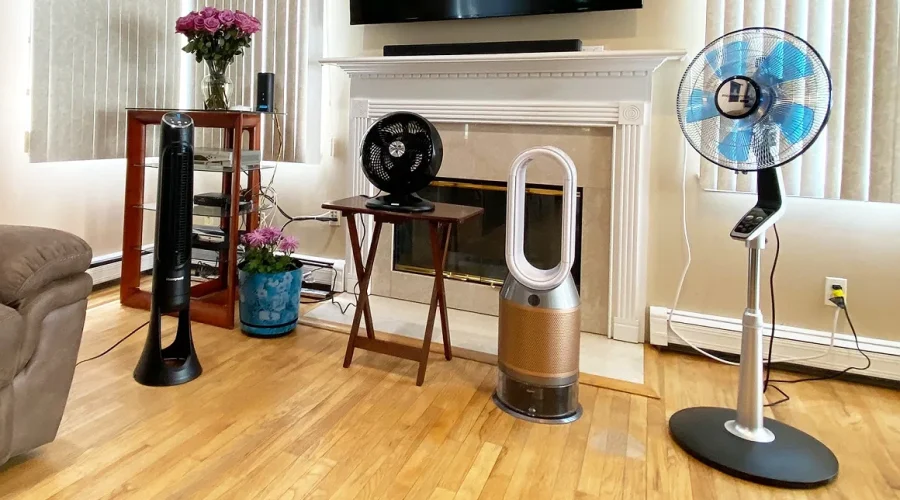What is a Cooling Fan?
A cooling fan is a device that moves air around. This helps reduce stuffiness and makes a room feel cooler. During hot weeks, even a budget a plug-in fan keeps the air moving. This helps sweat dry faster and surfaces feel less sticky. Whether I’m at my small office or on the couch, the right fan quickly turns muggy discomfort into a pleasant breeze. Some fans serve special purposes. For instance, engine-mounted fans push air through radiator parts to stop the motor from overheating.
At home, changing the blade direction makes a big difference. Set the blades up in winter and down in summer to shift how air moves across the ceiling and floor. This either pushes hot air out or brings cool air down. I’ve also watched my electric bill. A good Energy Star fan uses less energy while keeping my family just as comfortable as a louder, cheaper model.
How do cooling fans work?
Ever wondered how a cooling fan keeps your room or office from turning into a sauna during summer? It’s all about creating smooth airflow and efficient circulation. As someone who’s tested different models in both home and workspace settings, I’ve noticed that a good cooling fan does more than just spin its blades. It works in sync with a small motor that draws in air and pushes it out in a steady stream, helping to balance the ambient temperature in the room.
What makes this process smarter today is the integration of smart features and automation. Some models are built with a cooling fan relay, which acts like a gatekeeper, helping the fan operate only when needed, saving energy. Then there’s the fan switch for cooling, which lets you easily toggle between settings and manage the direction the air flows. Correct fan direction for cooling also plays a big role—angled just right, it spreads cool air evenly across the space. When everything works together with precise control, the result is a refreshing environment that feels naturally cooler without depending heavily on air conditioners.
What are the different types of cooling fans?
When I first went shopping for a simple cooling fan, I honestly thought Id grab the first decent one I saw and walk out. Many families now swear by a slender tower model-it looks slick, occupies almost no floor space, and whispers air into bedrooms or home offices. Yet on hot days a full-size pedestal fan is hard to beat; its height and adjustable head fling the breeze across a bigger room. In my living room, though, a plain low-profile floor fan still feels perfect; it sweeps a soft draft from the carpet right up to the ceiling.
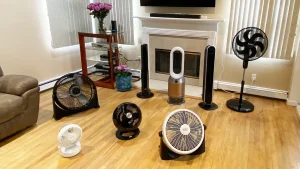
When I need sheer portability, a tiny clip-on or hand-held unit is my go-to hero. I snatch mine for a quick walk to the balcony, then slide it into a tote for outdoor movie night; it weighs next to nothing and charges by USB. Friends swear by the little desktop versions that sit inches away on a desk or nightstand, whispering cool air while they type or read.
Buy NowOn dusty, dry afternoons I flip on an evaporative fan; it adds just enough moisture to ease my throat and skin. And when the garage or workshop finally turns into a furnace, an old industrial fan blasts in to rescue the space.
What materials are commonly used in cooling fans?
When I first opened up a cooling fan assembly to troubleshoot a rattling sound, I was surprised by how carefully each part was made to support airflow and durability. Most cooling fans today rely on a mix of plastic and metal to balance weight and strength. The outer frame and grilles are often made from high-grade plastic which keeps the unit lightweight and easy to move. On the other hand, the inner rod and support structure may use metal to add much-needed stability to the build.
The cooling fan motor plays a crucial role and is typically enclosed in a well-sealed housing to protect it from dust and maintain long-term performance. Some fans also feature a filter, especially models meant for improving air quality, adding another layer to their functional design. During repairs, I’ve noticed that a faulty cooling fan resistor can cause the motor to stop or behave unpredictably, so using a durable one makes all the difference in a fan’s reliability. Every part contributes to how the fan is built to last, whether it’s a simple desk unit or a more powerful tower model.
Why Are Cooling Fans Important?
A cooling fan does more than just beat the heat. It helps improve your home’s airflow and overall comfort. Over the years, I’ve tried many models. They always stand out for how they create a fresh, breathable environment by keeping the air circulating. When you position the fan with the right cooling direction, you’ll notice how evenly the room cools, especially on stuffy summer days.
The best fan for cooling effectively balances ambient temperature without wasting energy. Whether I’m working in my home office or relaxing in the living room, having a user-friendly unit helps me adjust settings easily. Once you feel that steady stream of air flowing where you need it, you understand why every household and workspace needs a reliable cooling solution.
How Do Cooling Fans Improve Indoor Air Quality?
In my experience with various air cooling fan units at home and in small offices, I’ve noticed a real difference in how fresh the indoor air feels. A good cooling fan with water tank does more than cool a room. It makes the air feel lighter and more refreshing. The gentle airflow keeps the space comfortable and supports better circulation, reducing trapped air that carries pollution and dust. With the added moisture from a cooling fan with water tank, it helps balance humidity, especially in dry environments.
What impressed me most was trying an evaporative cooling fan last summer. It acted like a light purifier, pulling warm air through a moist filter to trap larger particles. I didn’t expect it to reduce VOCs or formaldehyde, but the air smelled clean and felt lighter, especially after cooking or with the windows closed. These fans are great for rooms where managing ambient air is tough. They work quietly and naturally, without chemicals or complex systems.
What Role Do Cooling Fans Play in Energy Efficiency?
When I replaced my bulky air conditioner with an energy efficient fan, I was shocked at how much it cut my power bills. A good electric cooling fan circulates air well while using much less energy than traditional systems. The key is how the fan adjusts to the ambient temperature. It cools without running at full blast all the time.
The performance of the best cooling fan comes from smart features like automation and smart plug compatibility. These let you schedule and control it from anywhere. My fan switched off automatically when the room cooled down, saving power. This improved its efficiency and kept watt consumption low, making it a smart long-term cooling choice.
Can cooling fans help reduce health risks?
I’ve struggled with sleeping in stuffy bedrooms during summer. I’ve learned how vital proper airflow is for rest. A cooling neck fan can be a lifesaver when you’re out and about. This is especially true in crowded places or during long walks. I’ve used the best neck cooling fan while hiking. The difference in my body temperature and energy levels was clear.
Good cooling fans also help keep clean air by circulating it well, especially if they have a filter. This boosts breathability, making it easier to relax and breathe. It even helps you fall into deeper sleep. When air sits still, it can trap dust and allergens, worsening respiratory issues. With steady airflow from a reliable fan, you create a comfortable space that supports your well-being day and night.
How to Choose the Right Cooling Fan?
Choosing the best cooling fan depends on how and where you’ll use it. I’ve tested everything from a cooling fan for rooms to a compact cooling fan for cars. I’ve learned that understanding airflow, direction, and footprint is key to finding the right one. For instance, if you’re shopping for a cooling fan for ps5, look for one that focuses on performance and has a quiet motor to fit your setup.
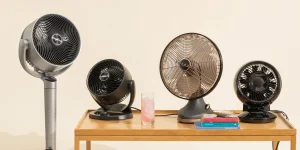
For a personal bedroom or living room, I prefer a cooling tower fan. Its vertical design saves space and provides strong circulation in tight spots. But usability and comfort are crucial, too. Choose a fan that suits your space and lifestyle. Consider the ambient conditions and select a fan that improves your comfort without being overwhelming. The right fan doesn’t just move air — it makes your space cooler and more pleasant.
What factors should you consider when buying a cooling fan?
When searching for the best cooling fan for my small apartment, I realized that looks and breeze strength aren’t everything. A good fan should balance energy efficiency with solid performance. I tested different models to check their watt usage at full power and found that choosing an efficient fan saved me money. Now, I always look at the cooling fan relay and cooling fan module. They help manage power and prevent overheating, especially when the fan runs for hours on hot summer days.
Buy Now
Another important factor is noise. Some fans are too loud and make it hard to concentrate or sleep. I always listen to the sound at different speed levels and check if there’s a timer so I can set it to turn off while I sleep. Easy control and smooth settings are also a must. A fan that’s hard to adjust or figure out ruins the experience. Above all, I focus on overall usability.
If it doesn’t fit my space or is tricky to move around, I skip it, no matter how fancy it looks. After trying many, I found that the best fan cooling experience comes from a mix of quiet operation, efficient power use, and thoughtful features.
How do you determine the appropriate size for your space?
When choosing the best fan for cooling room, I always consider how large the room is and how strong the airflow needs to be. From my personal experience during summer, a small compact fan simply doesn’t cut it in larger areas. Instead, a tower or pedestal cooling fan for room with wider circulation makes a big difference. It spreads cool air evenly, which keeps the entire room comfortable without needing to run the air conditioner all day.
What truly matters is the fan’s footprint—if you have a small space, a room cooling fan with a slim tower design saves space while still delivering enough airflow. But for bigger areas like a living room, I recommend going with a sturdy pedestal fan that offers more power and wider circulation. It’s all about matching the fan to the size of the space and not just picking one based on looks or price.
Which features should you look for in a cooling fan?
When I bought my first smart cooling fan, I realized how much difference the right features can make. If you want real comfort and convenience, look for fans that offer seamless app control.
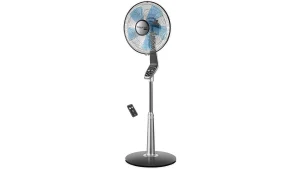 Being able to adjust settings, speed, and oscillation from your phone without leaving the couch was something I didn’t know I needed until I had it.
Being able to adjust settings, speed, and oscillation from your phone without leaving the couch was something I didn’t know I needed until I had it.
Another thing I noticed is how valuable a remote is for quick control, especially when you’re in bed or at your desk. For anyone seeking both performance and efficiency, choosing a cooling fan controller with smart automation and smart plug compatibility can truly upgrade your experience.
A built-in timer can help save energy, especially if you tend to fall asleep with your fan running. If you prefer a fan with water cooling, it adds that extra chill effect, especially in dry heat. And make sure the cooling fan control module allows precise direction adjustments to get airflow just where you need it.
Where Can You Use Cooling Fans Effectively?
Cooling fans are essential tools for both offices and homes. You can find small laptop coolers next to keyboards and larger models under gaming rigs. After hours of typing, I discovered that too much heat can slow down performance and harm sensitive parts. A compact travel fan keeps air flowing around your device, helping it run smoothly. Its light weight allows you to move it easily when your desk layout changes.
In other areas, a basic room fan can reduce muggy air in bedrooms and living rooms. This makes restless nights more comfortable. For those who drive often, a small car fan provides gentle airflow. This way, you don’t waste fuel and money by running the car’s AC constantly. Lastly, sleek tower or column fans fit into any decor. They offer quiet comfort while the heat waves rage outside.
Discovering the Ideal Spots for Maximum Cooling
From my own home setup and years of testing different fan models, I’ve learned that where you place your cooling fan for room can make a big difference. In the bedroom, I like to keep a bed cooling fan near the foot of the bed or on a table beside me. This placement helps improve airflow directly around the sleeping area, giving me that sweet, uninterrupted comfort on hot nights. Plus, when using a fan with a remote, it becomes so easy to change settings without getting up.
Another thing to consider is the footprint of your cooling fan for bedroom. Compact and sleek designs are best if you want to save space and still get great cooling power. Also, think about portability. I often move my fan from room to room during the day, and the lightweight design lets me do that easily. A fan with low noise is especially important at night so it doesn’t disturb your sleep, while still saving on energy by avoiding full AC use.
How can cooling fans be utilized in an office setting?
When working long hours in an office, staying cool is important for comfort and productivity. A desk cooling fan is a great choice for those who need direct airflow without disturbing others. Its compact size and small footprint allow it to fit easily beside your monitor or keyboard, keeping your workspace tidy. I use a laptop cooling fan to prevent my device from overheating during long video calls and design sessions. It runs quietly and takes up almost no space.
I also like fans that have a swivel head and remote control. This design makes it easy to adjust the breeze without leaving your desk. Whether you use a computer cooling fan for your PC tower or a smaller, portable option, good usability and convenience are essential. A well-placed fan in the office doesn’t just cool the air—it helps keep you focused and your equipment safe.
Can cooling fans be used outdoors?
If you have ever spent time in the backyard during a heatwave, you know how uncomfortable it can get. That’s where an outdoor cooling fan comes in handy.
These fans are built to last and tackle outdoor challenges like changing weather and high humidity. I’ve hosted family barbecues on hot summer days. A portable fan with wide oscillation kept everyone cool and the air moving, making the space much more comfortable.
If you’re planning a big event or need cooling for a temporary setup, consider checking for an outdoor cooling fan rental nearby. An evaporative cooling fan rental is also a good option. These rentals usually sit on a pedestal and provide strong airflow in open areas. They work great for patios, gardens, or outdoor dining spots. You won’t have to endure the heat, as these solutions are easy to set up and very effective.
What are the Benefits of Using Cooling Fans?
- I’ve tested many fans, and the best cooling fan stands out for its strong airflow and quiet performance. It makes any room feel relaxed and pleasant.
- A good cooling fan for room improves indoor comfort by circulating fresh air. This makes the space feel cleaner and less stuffy.
- I recommend the best fan for cooling because it saves money compared to running an AC all day.
- These fans work efficiently. They provide a cooler environment without using much energy. This is great for anyone watching their power bill.
- The steady circulation of cooling air keeps the temperature stable and enjoyable. This is especially important in bedrooms or home offices where airflow matters.
- Personally, I’ve found that fans not only keep me cool but also create a gentle breeze. This helps me focus better and sleep more peacefully.
Smarter Cooling with Less Cost
From my home setup on the hottest summer days, I learned that using an energy efficient cooling fan is a simple way to stay comfortable and save money. These fans consume less energy and fewer watts than traditional air conditioners. After I replaced my old unit with the best cooling fan I could find, I noticed better performance and a significant drop in my monthly electricity bill.
The secret is in their built-in efficiency. Many modern fans have features like a smart plug for automation based on temperature. I set my electric cooling fan to turn on only when the room gets too warm. This smart power use ensures the fan runs only when needed, reducing waste and helping me manage energy better.
Learn More
How can cooling fans enhance comfort during hot weather?
When the temperature rises and heat becomes unbearable, a cooling fan can help. At home, I use a room cooling fan to create a gentle breeze.
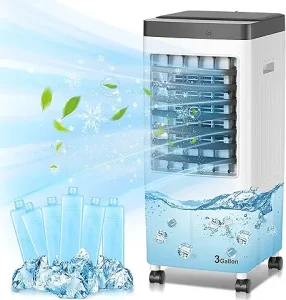
This keeps me relaxed even during the hottest afternoons. These fans improve airflow, spreading cool air evenly across the room. They provide instant relief and maintain steady air circulation, keeping everything feeling fresh.
One great benefit of an air cooling fan is the boost in comfort. Whether you’re trying to sleep or work, moving air reduces stuffiness.
It helps your body feel cooler. The right fan can transform a room’s atmosphere without high energy costs or noise. From my experience, choosing the right model is crucial. Once you find it, you’ll notice the difference from the first breeze.
What Maintenance Do Cooling Fans Require?
Over the years, I’ve learned that regular cleaning and attention to minor issues go a long way in keeping a cooling fan running smoothly. A dusty fan doesn’t just look bad — it can hurt the performance, stability, and even the durability of the unit. When dust builds up on blades, grilles, or the filter, the fan struggles to push air efficiently, which means it ends up working harder than it should. I always make sure to check and wipe these parts every few weeks for better usability and airflow.
One time, I ignored a slight wobble in the fan’s motion and found out later that the issue stemmed from a worn cooling fan resistor inside the cooling fan module. Thankfully, replacing it wasn’t complicated, though I did have to account for the cooling fan replacement cost, which reminded me how crucial preventive maintenance really is. A sturdy build is a plus, but even the best fans need proper care. Take it from me, clean it often, and inspect key components now and then. That habit can save you from unexpected reakdowns.
How often should you clean your cooling fan?
From my years of experience with fans, I know that cooling fan cleaning is key. Dust accumulates on the blades, grilles, and filter over time. This buildup can block airflow and hurt the fan’s performance. I check my fan every few weeks and clean it thoroughly each month, especially in summer when I use it daily. Regular cleaning boosts its efficiency and ensures long-term stability.
Many people ignore this simple part of fan maintenance, but keeping your fan clean really matters. A fan with too much cooling fan dust has a hard time circulating air and uses more power. With just a few minutes and the right tools, you can extend your fan’s life and enjoy fresher air indoors.
What are the common issues with cooling fans?
Sometimes, even the best cooling fan control module can cause problems if things inside it start to wear out. I’ve personally dealt with an ac fan running but not cooling, and trust me, it’s frustrating on a hot day. The issue often comes down to a faulty relay, a bad resistor, or a weak motor. These parts control how well your fan runs and how much cool air it delivers. When any of these fail, the performance drops, and the fan might spin but not actually cool your space.
Fixing it usually starts with proper troubleshooting. From my experience, checking the cooling fan relay switch should be your first step. It’s a small component, but it has a big impact. Replacing the module or resetting the setup may also be necessary if the problem continues. And if you start to hear unusual noise, that’s often a sign something inside is not working smoothly. Paying attention to these details helps keep your fan running efficiently and your environment cool.
What Innovations are Emerging in Cooling Fan Technology?
As someone who often tests new appliances, I’ve seen how the cooling fan industry is evolving. The rise of the smart cooling fan is a major change. These fans now offer more than just spinning blades. Features like automation and Alexa voice control bring real convenience to your home. With a connected app, I can manage my fan from my phone. I can adjust settings, turn it off or on, and even check the room’s airflow pattern, all from the couch.
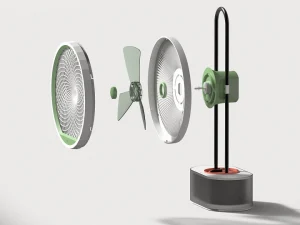
Modern fans like the Dyson cooling fan provide advanced control with smooth airflow and precise temperature management. Many models include a built-in cooling fan controller. This feature helps regulate speed and power based on your needs. Some even function as both a heating and cooling fan, providing comfort year-round. With features like scheduling, a clear LCD display, and easy use of a smart plug, today’s fans are far more than simple appliances. They show true innovation in daily living, designed to adapt to you, not the other way around.
What are the latest trends in cooling fan design?
Over the past few years, I’ve noticed a strong shift toward not just functionality but also style when choosing a cooling fan. One of the biggest trends is the rise of the best dyson fan for cooling, which blends innovation with a stunning modern look. People now want fans that not only cool the room but also fit well with their décor. I personally replaced my old bulky unit with a stylish cooling fan that complements my living space beautifully. These fans come in a sleek finish, feature a minimal footprint, and often have a vertical shape that saves space.
Shop Now
Another exciting development is the attention to aesthetic cooling fan choices. Manufacturers are focusing more on color, layout, and the overall design to make fans look like part of your interior setup. The build quality has improved too, offering both performance and an attractive appearance. Whether it’s for the bedroom or living room, the fan now plays a dual role: keeping you cool and adding visual appeal.
How is smart technology changing the way we use cooling fans?
Using a smart cooling fan in my home office has changed how I stay cool in summer. The best part is the cooling fan app control. It lets me manage the fan’s speed, direction, and timer right from my phone. With a few taps on the app, I can adjust the airflow without getting up. I especially love the Alexa cooling fan, which responds to voice commands. It’s perfect when I’m working and don’t want to pause.
These fans support automation and allow custom scheduling to fit your daily routine. Some models have a digital display for easy settings and a remote for quick control from across the room. Plugging it into a smart plug adds flexibility, letting me control it remotely while I’m away. Overall, the usability is smooth and intuitive, making smart home comfort easy for anyone. Find more expert picks and reviews at deepdivepicks.
Conclusion
After years of testing, I can say the best cooling fan does more than cool you down—it brings real comfort. A good cooling fan for room boosts airflow and improves your space’s overall usability. Whether in a large family room or a small office, a quality air cooling fan runs quietly and smoothly to keep you refreshed.
The real win comes from how much energy you save without sacrificing efficiency. I’ve noticed lower power bills and better indoor air with just a simple fan swap. A thoughtful choice here can make your space more breathable and far more pleasant during warmer months, all while being easy to use and adjust when needed.
FAQs
Do cooling fans really work?
Yes, a cooling fan improves airflow and creates a wind chill effect, making you feel cooler even if the temperature doesn't drop. It works best in dry environments by boosting sweat evaporation.
What type of fan is best to cool a room?
A tower fan or pedestal fan offers strong airflow and circulation. It fits nicely in any room, like a bedroom or living room. They combine effective design with minimal visual distraction.
Which is better, a cooling fan or a cooler?
An air cooler, using water evaporation, cools larger areas but uses more energy.
Do cooling fans really work?
Yes, a cooling fan improves airflow and creates a wind chill effect, making you feel cooler even if the temperature doesn't drop. It works best in dry environments by boosting sweat evaporation.
What type of fan is best to cool a room?
A tower fan or pedestal fan offers strong airflow and circulation. It fits nicely in any room, like a bedroom or living room. They combine effective design with minimal visual distraction.
Which is better, a cooling fan or a cooler?
An air cooler, using water evaporation, cools larger areas but uses more energy.
